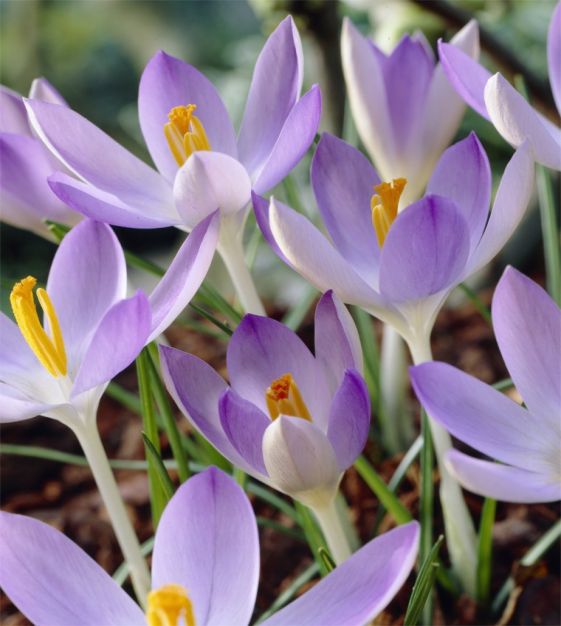-
- Website Specials
- New for 2025!
- Tulips
- Narcissi
- Allium
- Anemone blanda
- Brodiaea
- Camassia
- Chionodoxa
- Corydalis
- Crocus
- Eranthis
- Eremurus
- Erythronium
- Fritillaria
- Galanthus
- Geranium
- Gladiolus
- Hyacinths
- Hyacinthoides
- Ipheion uniflorum
- Dutch Iris
- Rock Garden Iris
- Ixiolirion
- Leucojum Aestivum
- Muscari
- Ornithogalum
- Oxalis
- Puschkinia
- Scilla
- Lilies
- Peonies
- Tender Bulbs
- Anemone Giants
- Tecolote Ranunculus
- Freesias
- Paperwhites
- Amaryllis
Crocus tommasinianus Lilac Beauty
Lilac Beauty has six-petaled, soft lilac flowers with a pink-violet interior, orange anthers and grass-like foliage with narrow, median silvery stripes. Its graceful 4" tall flowers open and close on sunny days. It has a finely reticulated tunic.
Crocus Class: Species. Bulb size: 5 cm/up. Full to partial sunlight. Bloom time in horticultural zone 5: Late March/early April. Plant 4" deep and 3" to 4" apart. HZ: 4-8. Height: 4".
Crocus are The Art & Soul of Spring.
Crocus Horticultural Tips Stinze Plantings
Crocus are The Art & Soul of Spring.
Crocus Horticultural Tips Stinze Plantings
- Information
Species Crocus
Species Crocus, commonly known as Snow Crocus, date back to before the 18th century, when they were native to Europe, North Africa and western Asia. They are the earliest Crocus to flower, sometimes at the same time as Galanthus and Iris reticulata; if not, they’ll bloom soon thereafter. Don’t worry about a surprise late spring snowfall; they normally recover as if it had never happened.
Blooming about two weeks before their Large Flowering siblings, Species Crocus are best for early spring lawn tapestries. To help the little Crocus bulbs (really corms) grow and naturalize, please hold off mowing the lawn until the Crocus foliage has died back completely, usually in six weeks or so. The prolonged period of photosynthesis and chlorophyll production helps the bulbs grow and give birth to bulblets attached to the mother bulb that you’ve planted.
Drifts of Species Crocus are also lovely along well-walked paths, in garden borders and in rock gardens. They have graceful six-petaled, 4" tall flowers that open and close on sunny days, and grass-like foliage that often has narrow, median silver stripes. Deer-resistant, they naturalize readily in well-draining soil and in full to partial sunlight. They may be a target for squirrels that may dig up newly planted bulbs for a snack, or to transplant elsewhere for surprise spring pop-up clusters. However, in the last decade or so, it’s been said that squirrels do not like varieties of Crocus tommassinianus. It’s worthwhile to give them a try if your garden is frequented by squirrels.
Again, Crocus naturalize by corm offsets (baby corms on the sides of the originally planted corm) and sometimes, when mature and happy over time, by self-sowing seed. Species Crocus have either smooth (annulate) or fibrous (reticulate or netted) tunics depending on the variety.
You’ll need about nine corms (bulbs) per square foot for a dense planting. (Square footage is determined multiplying the planting site’s length times its width.) Bulb size: 5 cm/up. Full to partial sunlight. Bloom time in horticultural zone 5: Late March/early April. Plant 4" deep and 3" to 4" apart. HZ: 4-8. Height: 4".
Crocus are also good for forcing indoors over the winter. Pot them up in mid-October and precool them at a consistent, dark 38°F to 45°F for eight to ten weeks with moderate weekly watering. Bring them into the house into progressively stronger sunlight. They will bloom about four weeks later.
Crocus are The Art & Soul of Spring.
Crocus Horticultural Tips Stinze Plantings
Species Crocus, commonly known as Snow Crocus, date back to before the 18th century, when they were native to Europe, North Africa and western Asia. They are the earliest Crocus to flower, sometimes at the same time as Galanthus and Iris reticulata; if not, they’ll bloom soon thereafter. Don’t worry about a surprise late spring snowfall; they normally recover as if it had never happened.
Blooming about two weeks before their Large Flowering siblings, Species Crocus are best for early spring lawn tapestries. To help the little Crocus bulbs (really corms) grow and naturalize, please hold off mowing the lawn until the Crocus foliage has died back completely, usually in six weeks or so. The prolonged period of photosynthesis and chlorophyll production helps the bulbs grow and give birth to bulblets attached to the mother bulb that you’ve planted.
Drifts of Species Crocus are also lovely along well-walked paths, in garden borders and in rock gardens. They have graceful six-petaled, 4" tall flowers that open and close on sunny days, and grass-like foliage that often has narrow, median silver stripes. Deer-resistant, they naturalize readily in well-draining soil and in full to partial sunlight. They may be a target for squirrels that may dig up newly planted bulbs for a snack, or to transplant elsewhere for surprise spring pop-up clusters. However, in the last decade or so, it’s been said that squirrels do not like varieties of Crocus tommassinianus. It’s worthwhile to give them a try if your garden is frequented by squirrels.
Again, Crocus naturalize by corm offsets (baby corms on the sides of the originally planted corm) and sometimes, when mature and happy over time, by self-sowing seed. Species Crocus have either smooth (annulate) or fibrous (reticulate or netted) tunics depending on the variety.
You’ll need about nine corms (bulbs) per square foot for a dense planting. (Square footage is determined multiplying the planting site’s length times its width.) Bulb size: 5 cm/up. Full to partial sunlight. Bloom time in horticultural zone 5: Late March/early April. Plant 4" deep and 3" to 4" apart. HZ: 4-8. Height: 4".
Crocus are also good for forcing indoors over the winter. Pot them up in mid-October and precool them at a consistent, dark 38°F to 45°F for eight to ten weeks with moderate weekly watering. Bring them into the house into progressively stronger sunlight. They will bloom about four weeks later.
Crocus are The Art & Soul of Spring.
Crocus Horticultural Tips Stinze Plantings
Species Crocus
Species Crocus, commonly known as Snow Crocus, date back to before the 18th century, when they were native to Europe, North Africa and western Asia. They are the earliest Crocus to flower, sometimes at the same time as Galanthus and Iris reticulata; if not, they’ll bloom soon thereafter. Don’t worry about a surprise late spring snowfall; they normally recover as if it had never happened.
Blooming about two weeks before their Large Flowering siblings, Species Crocus are best for early spring lawn tapestries. To help the little Crocus bulbs (really corms) grow and naturalize, please hold off mowing the lawn until the Crocus foliage has died back completely, usually in six weeks or so. The prolonged period of photosynthesis and chlorophyll production helps the bulbs grow and give birth to bulblets attached to the mother bulb that you’ve planted.
Drifts of Species Crocus are also lovely along well-walked paths, in garden borders and in rock gardens. They have graceful six-petaled, 4" tall flowers that open and close on sunny days, and grass-like foliage that often has narrow, median silver stripes. Deer-resistant, they naturalize readily in well-draining soil and in full to partial sunlight. They may be a target for squirrels that may dig up newly planted bulbs for a snack, or to transplant elsewhere for surprise spring pop-up clusters. However, in the last decade or so, it’s been said that squirrels do not like varieties of Crocus tommassinianus. It’s worthwhile to give them a try if your garden is frequented by squirrels.
Again, Crocus naturalize by corm offsets (baby corms on the sides of the originally planted corm) and sometimes, when mature and happy over time, by self-sowing seed. Species Crocus have either smooth (annulate) or fibrous (reticulate or netted) tunics depending on the variety.
You’ll need about nine corms (bulbs) per square foot for a dense planting. (Square footage is determined multiplying the planting site’s length times its width.) Bulb size: 5 cm/up. Full to partial sunlight. Bloom time in horticultural zone 5: Late March/early April. Plant 4" deep and 3" to 4" apart. HZ: 4-8. Height: 4".
Crocus are also good for forcing indoors over the winter. Pot them up in mid-October and precool them at a consistent, dark 38°F to 45°F for eight to ten weeks with moderate weekly watering. Bring them into the house into progressively stronger sunlight. They will bloom about four weeks later.
Crocus are The Art & Soul of Spring.
Crocus Horticultural Tips Stinze Plantings
Species Crocus, commonly known as Snow Crocus, date back to before the 18th century, when they were native to Europe, North Africa and western Asia. They are the earliest Crocus to flower, sometimes at the same time as Galanthus and Iris reticulata; if not, they’ll bloom soon thereafter. Don’t worry about a surprise late spring snowfall; they normally recover as if it had never happened.
Blooming about two weeks before their Large Flowering siblings, Species Crocus are best for early spring lawn tapestries. To help the little Crocus bulbs (really corms) grow and naturalize, please hold off mowing the lawn until the Crocus foliage has died back completely, usually in six weeks or so. The prolonged period of photosynthesis and chlorophyll production helps the bulbs grow and give birth to bulblets attached to the mother bulb that you’ve planted.
Drifts of Species Crocus are also lovely along well-walked paths, in garden borders and in rock gardens. They have graceful six-petaled, 4" tall flowers that open and close on sunny days, and grass-like foliage that often has narrow, median silver stripes. Deer-resistant, they naturalize readily in well-draining soil and in full to partial sunlight. They may be a target for squirrels that may dig up newly planted bulbs for a snack, or to transplant elsewhere for surprise spring pop-up clusters. However, in the last decade or so, it’s been said that squirrels do not like varieties of Crocus tommassinianus. It’s worthwhile to give them a try if your garden is frequented by squirrels.
Again, Crocus naturalize by corm offsets (baby corms on the sides of the originally planted corm) and sometimes, when mature and happy over time, by self-sowing seed. Species Crocus have either smooth (annulate) or fibrous (reticulate or netted) tunics depending on the variety.
You’ll need about nine corms (bulbs) per square foot for a dense planting. (Square footage is determined multiplying the planting site’s length times its width.) Bulb size: 5 cm/up. Full to partial sunlight. Bloom time in horticultural zone 5: Late March/early April. Plant 4" deep and 3" to 4" apart. HZ: 4-8. Height: 4".
Crocus are also good for forcing indoors over the winter. Pot them up in mid-October and precool them at a consistent, dark 38°F to 45°F for eight to ten weeks with moderate weekly watering. Bring them into the house into progressively stronger sunlight. They will bloom about four weeks later.
Crocus are The Art & Soul of Spring.
Crocus Horticultural Tips Stinze Plantings





